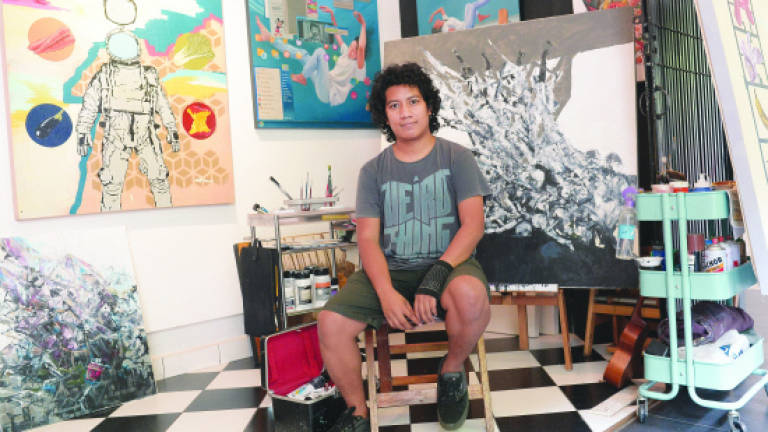Fusing nature with art

MANY people have the perception that art can only be done by the talented. According to Raja Azeem Idzham (also popularly known as Ajim Juxta), passion and perseverance play a major role in an artist's success as well. Without these key traits, it will be difficult to go far based on talent alone.
Azeem has been exposed to art from as young as the age of four. His late parents, while not artists, were art graduates and have imparted their appreciation and love for art to their children. In fact, the architecture graduate decided to pursue art full time after working for a while.
"The first few years were definitely tough. People tend to ask if I can cari makan (make a living) as an artist," Azeem recalled.
"I said, of course you can – but it is not easy."
Since then, Azeem has been working on his pieces in his gallerycum-studio, Titikmerah in Publika, which is shared with two other prominent artists.
"Working on my art here has allowed me to engage with passers-by and share about my work in person," Azeem said, adding that being on site helps break the stigma that all artists are reclusive.
Last April, Azeem was gifted a Young Art Award at the 2016 Young Art Taipei fair in Taiwan.
"Getting this award made all the difference in my career as an artist," enthused the 28-year-old.
Which genre would you say your art belongs to?
There's no specific genre for what I do. However, the closest answer would be a hybrid of architecture and conceptual, abstract art. It is also surreal and contemporary at the same time.
Where do you usually draw your inspiration from?
From the people around me, and the many issues we have – especially environmental ones. As you can see from my Arcology series, most of my work contains elements of nature. This series is my reaction towards the treatment of humans on the environment. It paints a bleak, dystopian future to remind us to do something before it's too late.
Tell us about the first piece of art you created.
The most memorable piece I can think of was created when I was about 10. I turned a 70 sen exercise book into a comic about superheroes and everyday life. My teacher was impressed when she saw it.
What were some of the toughest phases in your career as an artist?
The beginning is always tough when it comes to getting exposure, recognition and sales. It takes a lot of perseverance to go through this stage. Many artists would have already given up and gone back to the nine-to-five corporate life. I'm grateful that I managed to pull through those difficult moments; otherwise I wouldn't be where I am now.
If art were a superpower, what would you do with it?
Grow more trees, and reduce the amount of buildings that are not eco-friendly.
That said, what would your dream project look like?
I'd like to collaborate with architects and engineers to fuse our buildings with nature. I want to turn all of our skyscrapers into buildings that are sustainable and
Do you think social media has played a role in your success?
In some ways, it has helped me reach out to a community of people who heavily relies on social media to find artists. Fans sometimes turn into buyers; but social media shouldn't be the only outlet to rely on.
What is your daily routine like?
I usually sketch in the mornings, and by noon I'll be at Titikmerah to work on bigger pieces. The rest of the day is spent networking and responding to emails. People often ask if it's a real job. Yes, it is – minus the punchcard and dress code.
If you could go back in time, what would you tell your younger self?
Work hard, but remember to appreciate time with your family.